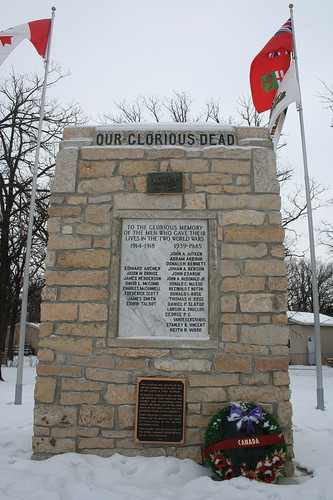This cenotaph was erected in 1924 and was remodeled in or about 1947 by the people of
In grateful tribute to the 230 men and women of
This plaque was placed here by the Royal Canadian Legion Branch 142 of Stony Mountain.
Geology:
During the Late Ordovician Period, a shallow sea covered almost two thirds of North America. The rocks at Stony Mountain consist of limestones and dolostones and were deposited as sediment on the floor of the ancient sea. The rock belongs to a geological unit known as the Stony Mountain Formation and is about 440 million years old.
When the last ice age retreated, prairie land and escarpments, such Stony Mountain, were left behind.
Samuel Lawrence Bedson (1842-1891)
Bedson became the first warden of the new federal penetantiary in Stony Mountain on February 2, 1877.
Having had no training in penal matters, Bedson applied strict military discipline, tempered with common sense and a warm humanity towards all. He insisted that his charges have proper food, clothing, quarters, and medical care, and that they be given meaningful work to do – erecting or repairing buildings, gardening, tending livestock, or shoemaking. He also started a school for illiterate prisoners. His work and the condition of the prison and its inmates were consistently praised in the yearly reports of the federal inspector.
Bedson and his wife Jemima were renowned for the hospitality shown to all guests, from Governor General Lord Dufferand Lady Dufferin, who came to open the Stony Mountain Penitentiary in August 1877, to other official visitors, employees, and friends. At these times “Bedson was in his element for he liked people to come together for any kind of social event.” He was an avid sportsman and for his friends and visitors he set up a six-hole golf-course, a curling rink, a race-track, and a hunting club, as well as a private zoo where he kept a famous buffalo herd. In 1888, when he disposed of the herd, it numbered 110 head, including both thoroughbred and cow-buffalo breeds.
© 2000 University of Toronto/Université Laval
-taken from the Interlake Development Corporation
Our History
